2012, 32th IAJGS International Conference on Jewish Genealogy, PARIS, JULY 15 - 18
Related to: General Bessarabia,
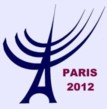
32nd IAJGS INTERNATIONAL CONFERENCE ON JEWISH GENEALOGY
JULY 15 - 18, 2012
JULY 15 at 2:00pm - SIG and BOF's fair
JULY 15 at 3:30pm - Interpretation of Russian documents of the 19th century. Speaker Jane Rollins, Montrose CA, active member of Bessarabia SIG.
This workshop will describe what types of 19th century documents written in Cyrillic may be available to genealogists and where they may be found. Attendees will see the 32 characters in the Russian alphabet and how certain characters resemble those of English, but do not signify the same sound. The speaker will show examples of how handwritten 19th century Cyrillic differs from the printed Cyrillic used today, and what standard Russian phrases are used in columnar and narrative vital records from the period. With this training, attendees will be able to identify family names on the index pages of vital records registers. They will then be able to locate and pinpoint which entry belongs to their ancestors from several that appear on each register page.
JULY 16 at 4:40pm - Bessarabia SIG meeting.
Text of the presentation.
The meeting is open to anyone with roots in the region historically known as Bessarabia, an area now comprising the Moldova Republic and parts of Ukraine. At the end of the 19th century and before the War, Bessarabia had significant Jewish presence. The Bessarabia SIG was organized at the end of 2011 to help people in their Bessarabian genealogical research.
Yefim Kogan, born in Kishinev, Moldova, Bessarabia SIG Coordinator, will discuss the progress of the multiple projects started by the SIG members and many future proposed projects. He will also talk about connections made by Bessarabia SIG with Jewish communities in Moldova, and with non-Jews interested in helping Jews to find fragments of the lost Jewish life in their towns.
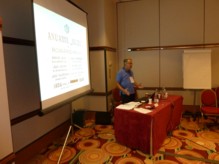 |
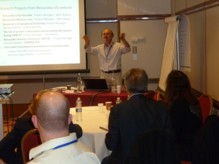 |
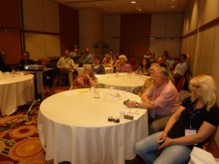 |
| Harvey Kabaker, Project Leader presents how he with the group of translators completed the Bessarabia Business directory project.
|
Yefim Kogan, Bessarabia SIG Coordinator gives a progress report on Bessarabia SIG projects.
|
At the Bessarabia SIG Meeting
|
JULY 17 at 10:20am - Estate and other categories of Jews in Bessarabia, Russia in 19th century. Speaker Yefim Kogan, Newton, MA.
Text of the lecture.
The Law of Russian Empire of 1818 obliged Bessarabian Jews to be registered in one of several estates – Merchants, Middle Class (Petty Bourgeois, Tradesmen, Townsmen) or Farmers (Land-workers, Peasants). Similar Laws were enforced by Russia in Belarus, Ukraine, Novo Russia and other regions, at the end of the 18th century, beginning of the 19th century. What did these estates mean to Jews? What privileges did these estates grant? How could Jews change their estates, if at all? The other categories of Jews were: Honorary Citizens (hereditary, private), Nobility, Colonists, Foreigners, and Military personal, State-Owned Settlers, Burlak – Temporary worker. Information was taken from Vital & Revision Lists records of Bessarabia, Bessarabian Annual Book-Calendar, the Governor Office, 1862-1914, etc.
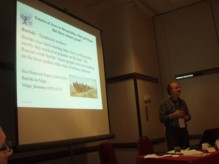 |
| At the Lecture.
|
JULY 17 at 11:20am - Entre Généalogie et Histoire : la contextualisation des personnages. Essai de typologisation
appliquée au cas bessarabien. Speaker Vincent Vagman, Belgium
Après avoir brièvement précisé la notion de contextualisation des personnages située à l'intersection
de l'histoire et de la généalogie, la conférence prendra appui sur une recherche de plusieurs années
consacrée à des ancêtres originaires d'Akkerman (aujourd'hui Belgorod Dnevstrovski - Ukraine)
pour suggérer des pistes pratiques de recherche.
Il sera procédé à la présentation d'un inventaire de travaux ou de sources écrites ainsi
qu'iconographiques actuellement ou prochainement accessibles en ligne. Des questions telles que
les modalités et facteurs d'émigration, les conditions économiques, le renouvellement des prismes
culturels ou l'approche localisée des massacres de l'été 1941 seront abordées concrètement pour
illustrer les potentialités de contextualisation offertes par cet inventaire.
L'exploitation de cet inventaire se clôturera en envisageant la problématique délicate consistant à
recourir à l'analogie en l'absence de sources personnalisées.
La conclusion de cette conférence soulignera de ce fait l'apport d'une micro histoire axée sur des
trajectoires personnelles en comparaison avec la description souvent anonyme de quelques uns des
grands enchaînements qui ont déterminé le déroulement du XXème siècle dans la population juive
européenne.
Contextualizing Individuals. The Bessarabian case as typical.
English translation of the lecture.
After a short explanation of the concept of contextualization of individuals at the intersection of history and genealogy, the lecture will develop upon several years of research devoted to ancestors from Akkerman (now Belgorod Dnevstrovski - Ukraine ) to suggest avenues for practical research. There will then be a presentation of an inventory of historical works and written and iconographic sources that are currently or will soon become available online.
Issues such as factors of emigration, economic conditions, renewal of cultural perspectives, and localized influences typified by the massacres of the summer of 1941, will be specifically discussed to illustrate the potential of contextualization in research techniques and analysis.
The discussion of these issues will conclude by considering the sensitive issue of resorting to analogy (hypothetical situations) in the absence of concrete, reliable personal data and sources, thus highlighting the use and importance of individual stories, micro-histories, and personal journeys vis-a-vis the more common practice today of using anonymous individuals swept along by the grand historic events that have determined the course of European Jewish population in the twentieth century.
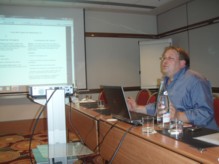 |
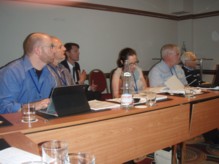 |
| Vincent Vagman, Belgium.
|
'English' block of people with special translator assigned.
|
JULY 18 at 11:20am - Archival documents referring to Jewish roots in Moldova (formerly Bessarabia). Speaker Alla Chastina, Kishinev, Moldova.
Text of the lecture.
The first reference guide to read is “Jewish roots in Ukraine and Moldova. Pages from the Past and Archival Inventories”, book written by Miriam Weiner in 2000. It listed precise inventories of the vast Jewish materials in the Archive of Moldova, compiled in collaboration with Moldovan archivists.
But now this volume can be supplemented by recently discovered archival documents. Some go back to 1849, 1868, 1875 1910 and so on. Last year the Archive has received about 5000 personal folders of many victims of political repression, including many personal Jewish files from the Archive of State Security of Moldova. Now this records are being indexed.
I will also explain the ways to visit the National Archives and to obtain access to the documents.
We hope that in the near future all Moldovan Archives will have well functioning websites and first-class specialists will begin digitizing our rich archival inventories for presenting them on-line so every person can trace family roots in Moldova.
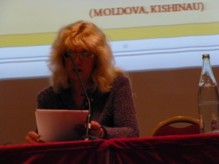 |
| Alla Chastina presenting at the conference.
|
Paris, Paris!
 |
 |
| View from the upper floor of the conference hotel.
|
Always on a lookup... Book store owned by Kogan, but the owner's family was from Galicia.
Yefim Kogan
|
All photos on this page are courtesy of Vincent Vagman, Belgium, Yefim Kogan, USA and Alla Chastina, Kishinev, Moldova.